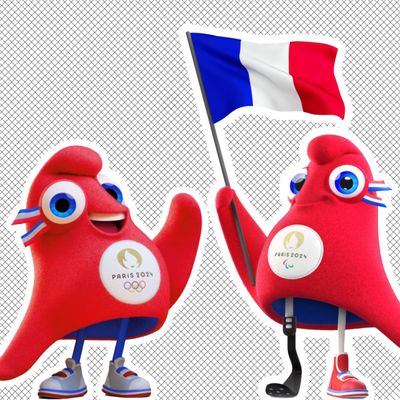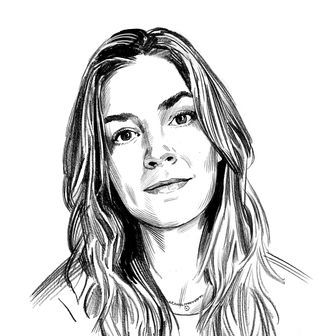
The French have made several contributions to international culture that are so indelible, so singular, the nation gets to put its name on them: French bread, for example; French onion soup; and, of course, French kissing. As if to honor that last one, arguably the country’s greatest innovation to date, France — as host of the 2024 Olympic and Paralympic Games, set to open in Paris on July 26 — has elected what appear to be a pair of disembodied tongues to act as its mascots. They are vividly rouge and gently triangular with flipped little tips, like someone froze them mid-lick, and they will waggle all around the City of Light over 30 cumulative days of athletic competition. They look so much like tongues that it feels impossible to believe they could be anything else, and yet Olympic sources insist that they are not tongues but Phryges, an anthropomorphized version of a historically important hat that is dear to the French national consciousness. These animated chapeaus fit neatly within the country’s traditions of republicanism and scheming up bonkers Olympic mascots. Whereas most host nations opt for an animal — in 2022, Beijing chose a panda, for example; in 2018, PyeongChang had a white tiger — the French instead deputized “an ideal,” as Paris 2024 president Tony Estanguet explained in November, when he sprung les Phryges on the world. They are “a very strong symbol for the French Republic.” How? Well …
What is a Phryge?
Despite their resemblance to the McDonald’s Grimace (who is himself a giant taste bud), les Phryges are actually supposed to evoke triangular red phrygian caps, similar to beanies in shape if not in import. According to Smithsonian magazine, the phrygian cap is a relative of the Roman pileus, a cap worn by freed slaves as a marker of that status. The early phryges surfaced in western Europe during the 17th century, when the English developed a taste for Greco-Roman antiquities. From there, the hat traveled to the American colonies, where it reportedly appeared — in the most American terms possible — as a “liberty cap,” emblazoned on an obelisk Paul Revere designed in protest of the Stamp Act. The liberty cap entrenched itself as a symbol of the American Revolution, appearing on our early currency and, per the Smithsonian, on inaugural iterations of Uncle Sam.
Maybe more famously, phrygian caps showed up on the heads of French republicans beginning around 1789. They appear in paintings and imagery commemorating the revolution, as a symbol of the liberté, égalité, et fraternité at the core of the French Republic. Phrygian caps sit “atop the head of the iconic figure Marianne in every town hall,” per Olympics.com, and as we will all recall, Marianne — the mythic Frenchwoman who personifies la France — also features prominently in the branding for these Olympic Games, along with her stunning new bob.
What are these Phryges, really?
They are human-size red triangles with the sort of round, unblinking eyes one finds on a stuffed animal, only lashed by the “cockade of France,” which is to say, “a knot of ribbons that is the French national ornament,” according to Olympics.com. They are supposed to have a “mischievous and expressive” look about them, and although les Phryges apparently run in a pack of indeterminate size, France has only seen fit to tell us about two of them. As NBC reports, the Olympic Phryge is the “tactician” of the group, while the Paralympic Phryge — which uses a prosthetic running blade — is, for some reason, “a party animal, spontaneous, and a bit hotheaded.” One can only hope that their assigned personalities will emerge in the course of competition.
What do the Phrygian duties include?
As Olympics.com describes it, their task is “to show the world that sport can change everything and that it deserves to play a major role in society.” It’s a big job, and it’s unclear how they plan to tackle it, save for wandering around at Olympic events.
“According to our narrative, they have existed for thousands of years and were present during several key events in French history,” Paris 2024 brand director Julie Matikhine explained of the caps. “Now they have returned for this big event in France to lead a mission of revolution through sport. The aim is to show that sport can change everything in society. The objective is to show that sport and its values can do great things. It’s about fraternity and solidarity, and it helps society grow.” Le shrug!
How do people feel about les Phryges?
Whether or not their symbolism resonates with the nation they represent seems to depend on whom you ask. As the Guardian reported, live from Paris in November, many in France felt the mascots looked like a “clitoris in trainers,” though they didn’t necessarily view that as a bad thing; indeed, one poll (commissioned by Paris 2024, it must be said) declared that “a large majority of French people appreciate the mascots.” How large? According to the survey, 75 percent of adult respondents said they liked them, and 83 percent of children ages 6 to 17 agreed. A purported 85 percent of French adults and 86 percent of French children are said to have deemed them “easily recognizable,” though as what, the press release didn’t clarify. Still, most of those polled nonetheless felt les Phryges were “original” and “cute,” which is probably a win.
You mentioned that these weren’t the only weird Olympic mascots in the French oeuvre?
Correct. The last time the country hosted an Olympics — in 1968 in Grenoble — it dispatched a bobblehead zigzag on skis to represent them. Named Schuss, it was inventive not only for its wacky appearance but also (and mainly) for being the first Olympic mascot ever to exist. Per Olympics.com, Schuss established mascots as “fun and festive ambassadors of the Olympic Movement.” And, honestly, what is more fun and festive than a couple of red hats?
A couple of large sentient tongues, probably.


